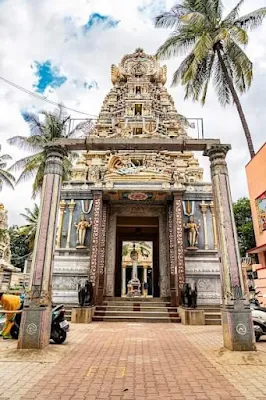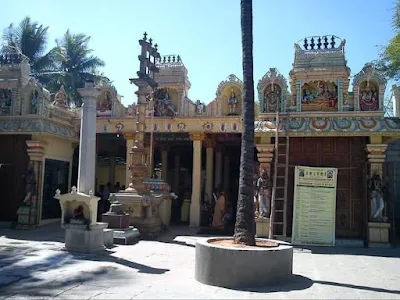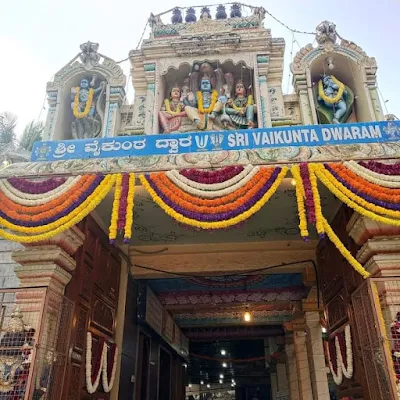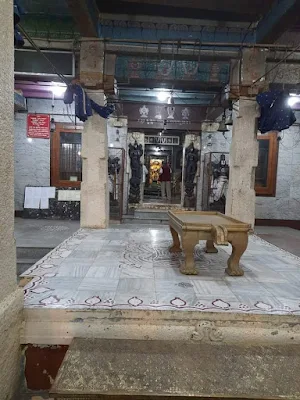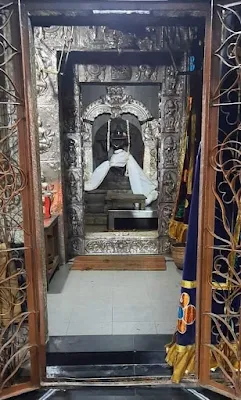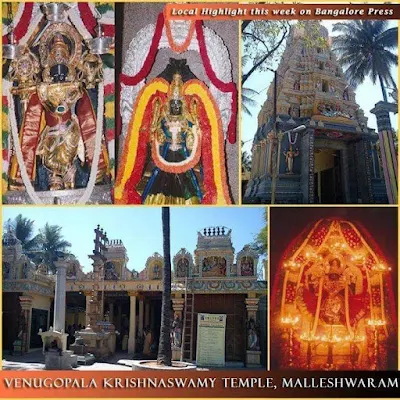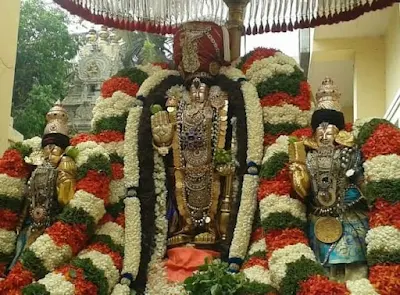Did you know that Sri Venugopalaswamy Temple in Malleshwara in Bengaluru, though built in 1902, is reckoned ancient as it is deified with the Moola Vigraha of Lord Krishna playing the flute which had been earlier consecrated in or before 997 AD at Tirukadaluru in Tamilnadu?
Sri Venugopalaswamy Temple, popularly known as "Krishnar Kovil", is located in the predominantly Srivaishnava suburb of Malleshwaram, also spelled Malleshwara (ಮಲ್ಲೇಶ್ವರ), which developed as a suburb in 1892 in Bengaluru after a plague epidemic. The temple structure as such was the result of the efforts of prominent residents of Malleshwara, who in 1902 AD sought the help of then queen, Maharani Kempa Nanjammani Vani Vilasa Sannidhana of Mysore Kingdom; she was the queen regent following the untimely death of Chamaraja Wodeyar X, as their son Krishnaraja Wodeyar was a minor until 1902 . The queen readily agreed to not only partly fund (seed money) the building of the Vishnu Temple with a generous donation of 3,750 varahas (the then unit of currency of the Mysore Kingdom) but also decided to shift many of the ancient (of 10th century vintage or even going back to Chola reign) Vigrahas (iconic idols ) including the Moola Vigraha of Lord Krishna playing the flute which were then housed in the Mysore palace or in some other temple locations.
Following the patronage provided by the regent queen of the Wadiyar Kingdom of Mysore, the enlightened public personages of Malleshwara (such as Shetlur Venkataranga Iyengar, Professor M T Narayana Iyengar, Rao Bahadur Narasimhacharya, M T Narasimha Iyengar and Vidwan Asuri Anandalvar Swamy and others) also raised a large sum of 11, 794 varahas to build the Vishnu Temple at a site selected for the purpose; the site measured 140' East to West and 250' North to South between 11th cross on the northern side and 10th cross on the southern side of the Malleshwara suburb of Bangalore (now Bengaluru). It was initially thought to deify Nambinarayan as the Mulavar deity (Principal Idol) but during the construction stage, it was changed to Lord Sri Venugopalaswamy. This change is attributed to a patron who was ordained by God in a dream to install Venugopalaswamy or Lord Krishna playing the flute as the main deity. This Archa Moola Vigraha gave this 20th century temple its ancient vintage charachter dated to 997 AD as originally it belonged to a ruined temple in Thirukudallur in Tamil Nadu and is believed to have been worshipped even during the Chola rule in the 9th century. It is said that in 1829 this deity had reached the Mysore kingdom. In 1902, with the help of an officer of the palace, Sri Srikantharaje Urs, the Queen regent of Mysore, the Maharani, approved its transfer to this temple.
With the completion of the establishment of the main temple, with the Garba Griha deified with the Archa Vigraha of Venugopala swamy, the formal consecration (Pratishtapane or Kumbaabhishekam) of all deities was done on August 22, 1902, on an auspicious day of Bahula Tritiya of Shravana Maasa (Simha maasa) of Shubha Kritha naama samvatsara, Uttarabhadra nakshatra as per the Hindu calendar; the presiding deity of Lord Krishna, standing to about a metre height, is seen holding flute in his both hands, with his left leg on the peetha (pedestal). On the same day, the Vigraha of Lord Hanuman facing east, was also consecrated in an adjoining shrine. This day also happened to be the crowning (Pattabisheka) day of the Maharaja Nalvadi Krishnaraja Wodeyar.
The temple complex, established in accordance with Pancharaatra Agama and Vedic principles, has a plethora of Vigrahas deified in its garba griha (sanctum sanctorum) and other various sannidhis (shrines). These vigrahas, apart from the Moola Vigraha of Venugopalaswamy, Krishna playing the flute in the garba griha, are: Sri Nambinarayana, also said to be of 10th century vintage; Utsava-murtis of Venugopala Krishnaswamy with His Ubyanachiyars (Consorts) Sridevi, Bhudevi; Sri Veera Anjaneyaswamy vigraha moved from a small shrine in Narayana Katte (Sanyasi Katte), Periya tayar deity (Goddess Mahalakshmi); the Thayar (Principal Goddess) deity with chaturbhuja, abhayahasta and padmahasta was earlier receiving regular pooja at an old temple in Terukanambi in Gundlupet; the Shathari was brought from Tirunarayanapura (Melukote) where it had been consecrated. In recent times sannidhis for Rukmini, Andal (consecrated in 1946) Rama - Lakshmana - Sita with Anjaneya have also been built within the complex. Also housed in the temple complex are icons of Tirumangai Alwar, Sri Vedanta Deshikar, Manavala Mamuni, all consecrated in 1980. The deity of Sudarshana Alwar was consecrated in the late eighties, and that of Navaneeta Krishna also known as Ambegalu Krishna or Laddu Gopala was consecrated in 2005.
The temple complex standing out shining as a beautiful monumental structure built in the Vijayanagara architectural style of Hampi, covers an area of about 0.8 acres; it was built under the direction of R Narasimhachar, who was then the Director of Archaeology department with the Government of Mysore. It has an impressive five-tiered entrance Rajagopura at the center flanked on either side by a compound wall topped by Stucco images of gods and goddesses. This is followed by Mukha Mandapa, chatur dwara, veda stambha or the Dwajasthambha with Garuda shrine, and Vasantamandapa and garba griha. The garba griha is topped by a Vimana Gopura. In particular is the Darpana Mandapam (a hall of mirrors), a hexagonally shaped hall where during Shayanotsava (where the Lord rests on Adisesha in a sleeping posture) the devotees are delighted to witness an all endearing sight with more than 275 reflections of the Utsava Murthy, visible due to the mirrors.
The Temple worship here is a rigorous daily practice both during morning/day and evening/night in specfied hours, following the Pancharatra Agama shastra dictums. Brahmotsava is a grand festival held for ten days during the month of March which culminates in a grand Ratha yatra (car festival). Other important festivals celebrated here are Rama Navami, Vaikuntha Ekadashi, Oonjal Utsava (Jhulan Utsava), Krishna Janmashtami, Garuda Utsava, etc. There are about 250 major and minor festivals celebrated every year at this temple.
- Narasipur Char
